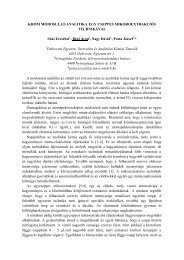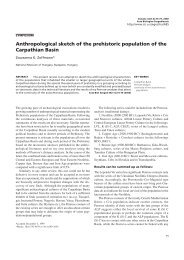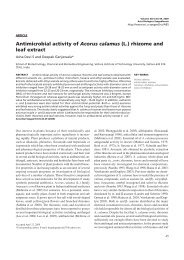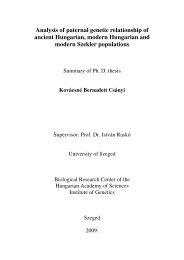principles of extraction and the extraction of semivolatile organics ...
principles of extraction and the extraction of semivolatile organics ...
principles of extraction and the extraction of semivolatile organics ...
You also want an ePaper? Increase the reach of your titles
YUMPU automatically turns print PDFs into web optimized ePapers that Google loves.
84 <strong>principles</strong> <strong>of</strong> <strong>extraction</strong><br />
physically adsorbed water, dehydrated oxide, geminal silanol, <strong>and</strong> bound<br />
<strong>and</strong> reactive silanol. Porous silica consists <strong>of</strong> a directly accessible external<br />
surface <strong>and</strong> internal pores accessible only to molecules approximately less<br />
than 12,000 Da [86]. Pesek <strong>and</strong> Matyska [87] have reviewed <strong>the</strong> chemical<br />
<strong>and</strong> physical properties <strong>of</strong> silica.<br />
Silica particles used for SPE sorbents are typically irregularly shaped, 40<br />
to 60 mm in diameter. Silica particles used for sorbents in high-performance<br />
liquid chromatographic (HPLC) columns are generally spherical <strong>and</strong> 3 to<br />
5 mm in diameter. Due to <strong>the</strong> di¤erences in size <strong>and</strong> shape, SPE sorbents<br />
are less expensive than HPLC sorbents. Much greater pressures are required<br />
to pump solvents through <strong>the</strong> smaller particle sizes used in HPLC.<br />
Apolar Polymeric Resins<br />
Syn<strong>the</strong>tic styrene–divinylbenzene <strong>and</strong> o<strong>the</strong>r polymers, particularly <strong>the</strong> trademarked<br />
XAD resins developed by Rohm & Haas, were used for SPE in <strong>the</strong><br />
late 1960s <strong>and</strong> early 1970s. However, <strong>the</strong> particle size <strong>of</strong> <strong>the</strong> XAD resins<br />
is too large for e‰cient SPE applications, <strong>and</strong> <strong>the</strong>refore <strong>the</strong> resins require<br />
additional grinding <strong>and</strong> sizing. Also, intensive purification procedures are<br />
needed for XAD resins [73,75].<br />
In <strong>the</strong> latter half <strong>of</strong> <strong>the</strong> 1990s, porous, highly cross-linked polystyrene–<br />
divinylbenzene (PS-DVB) resins with smaller, spherical particle sizes more<br />
suitable for SPE uses became available (Figure 2.23). The new generation <strong>of</strong><br />
apolar polymeric resins is produced in more purified form, reducing <strong>the</strong> level<br />
<strong>of</strong> impurities extracted from <strong>the</strong> sorbent. Polymeric resins are discussed in<br />
more detail by Huck <strong>and</strong> Bonn [69], Fritz [73], Thurman <strong>and</strong> Mills [75], <strong>and</strong><br />
Pesek <strong>and</strong> Matyska [87].<br />
The enhanced performance <strong>of</strong> PS-DVB resins is due to <strong>the</strong>ir highly<br />
hydrophobic character <strong>and</strong> greater surface area as compared to <strong>the</strong> bonded<br />
silica sorbents, which are discussed in <strong>the</strong> following section. The strong<br />
sorption properties <strong>of</strong> PS-DVB resins may arise from <strong>the</strong> aromatic, poly-<br />
Figure 2.23. Cross-linked styrene–divinylbenzene<br />
copolymer.<br />
(<br />
(<br />
) n<br />
)<br />
n














